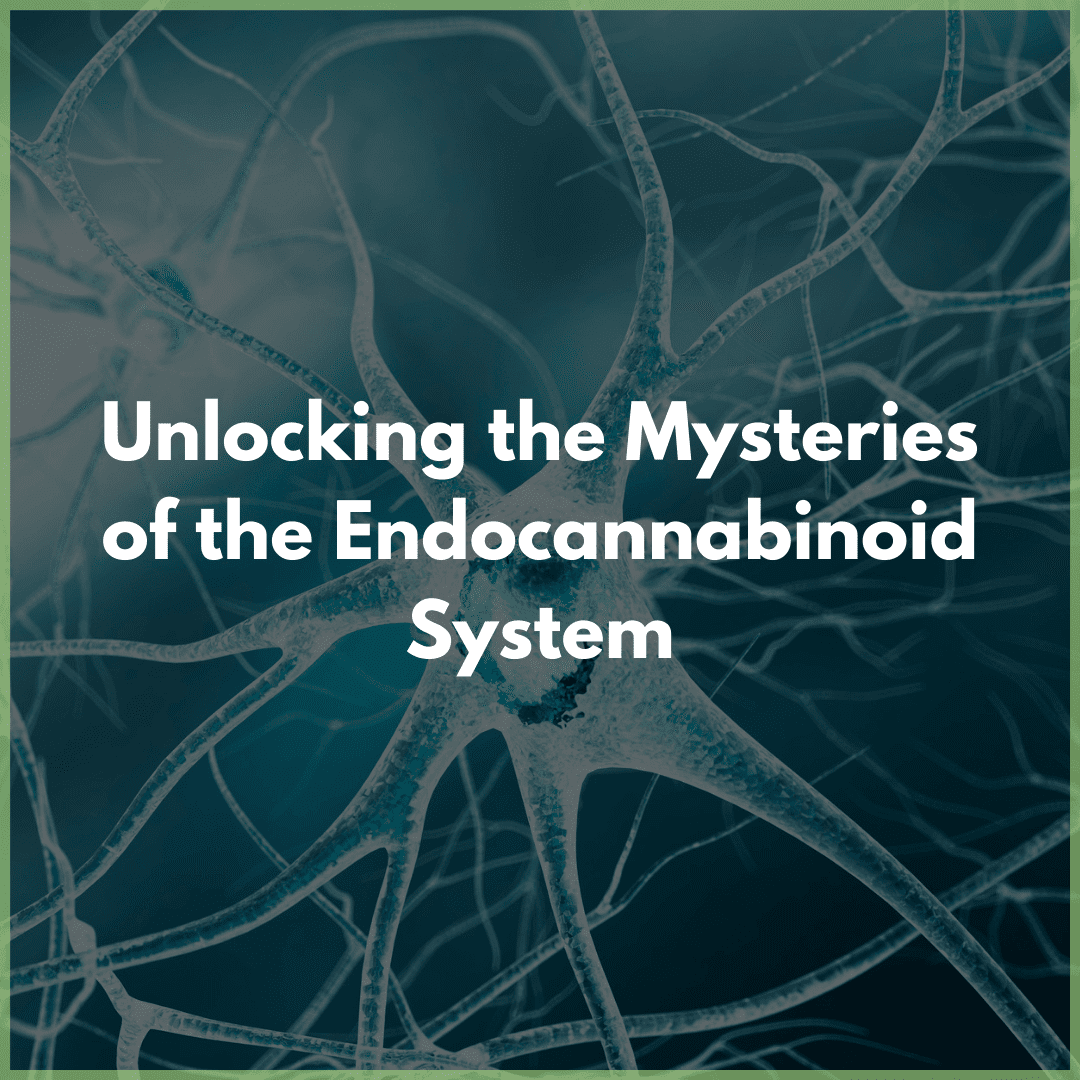
The endocannabinoid system: a network of receptors, enzymes and molecules working together to keep our body in balance. But what is it and how does it affect our health and wellbeing?
In this post, we’ll cover the history of the endocannabinoid system, how it regulates various physiological processes, latest research and its potential benefits.
Summary
- The endocannabinoid system is a network of chemical signals and cellular receptors that regulate various bodily functions.
- External cannabinoids like THC and CBD interact with the endocannabinoid system to provide potential benefits for autoimmune conditions and anxiety disorders.
- Research is focused on targeting specific parts of the endocannabinoid system to find its medical applications.
The Endocannabinoid System
The endocannabinoid system (ECS) is a complex network of chemical signals and cellular receptors spread throughout the brain and body.
It’s responsible for homeostasis, the delicate internal balance that keeps our bodies running smoothly.
The ECS is made up of three main components: endocannabinoids, receptors and enzymes.
Endogenous cannabinoids, or endocannabinoids, are neurotransmitters produced by our bodies to regulate a wide range of physiological processes, such as appetite, mood and immune response.
These chemical messengers bind to cannabinoid receptors which are found throughout the body.
Human cannabinoid receptors consist of two types: CB1 and CB2. CB1 receptors are found in the central nervous system and CB2 receptors are found in the immune system.
Together, they form the endogenous cannabinoid system, which responds to various stimuli through endocannabinoid signalling.
The Discovery of the Endocannabinoid System
The endocannabinoid system was discovered during the research of cannabinoid receptors in the late 80s and early 90s.
This was a major breakthrough in understanding how cannabinoids, like those found in the cannabis plant, interact with our bodies.
Researchers realised our bodies produce their own cannabinoids, called endocannabinoids, which bind to these receptors and impact our health and wellbeing.
Since then the field of endocannabinoid research has grown exponentially with the International Cannabinoid Research Society and many other organisations dedicated to studying this complex biological system.
Endocannabinoids
Endocannabinoids are naturally occurring molecules that regulate various bodily functions by binding to cannabinoid receptors
Two endocannabinoids have been identified so far: anandamide and 2-arachidonoylglycerol (2-AG).
The effects of endocannabinoids binding to receptors depend on the location of the receptor and the type of endocannabinoid it binds to.
For example, endocannabinoids can modulate intestinal motility and the smooth muscles associated with the digestive, urinary and reproductive systems.
Endocannabinoids have many functions in the body including:
- Playing a role in the process of memory extinction, which is essential for coping with traumatic life experiences.
- Increased endocannabinoid signalling in the central nervous system has a sleep inducing effect.
- Regulating anxiety dependent behaviour.
These are just a few examples of the many ways endocannabinoids modulate various physiological processes and overall health.
Cannabinoid Receptors: CB1 and CB2
As mentioned above CB1 and CB2 are the two main cannabinoid receptors found throughout the body.
CB1 receptors are mainly found in the brain and nervous system and peripheral organs and tissues.
They are also the main target of the endogenous partial agonist anandamide (AEA) and exogenous THC, the most well known cannabinoid in cannabis.
CB1 receptors modulate neuronal excitability by controlling neurotransmitter release and regulating synaptic plasticity. And are involved in various processes such as learning, memory and mood.
CB2 receptors, however, are found in the immune system and play a key role in regulating inflammation and immune response.
They can also interact with immune cells and help regulate immune functions and maintain immune homeostasis.
By targeting these receptors scientists are working on potential therapeutic benefits for various medical conditions such as autoimmune and inflammatory disorders.
External Cannabinoids
External cannabinoids like THC and CBD can interact with the endocannabinoid system and lead to various effects depending on the type of cannabinoid and the receptors they bind to.
THC binds to CB1 receptors in the central nervous system and produces psychoactive effects and potentially therapeutic benefits for conditions like chronic pain and anxiety.
CBD, found in full spectrum cannabidiol oils, binds to the peripheral nervous system and targets CB2 receptors and may have potentially therapeutic effects without the psychoactive effects of THC.
Medical benefits aside, many attribute the well-being-supporting effects of products such as transdermal CBD patches to its interaction with the endocannabinoid system.
Endocannabinoid System and Medical Research
The potential therapeutic applications of the endocannabinoid system are:
- Pain
- Mood disorders
- Neurological disorders
- Inflammation
- Sleep disorders
- Appetite regulation
- Addiction treatment
The endocannabinoid system is an area of medical research with new medicines being developed by targeting specific receptors.
Current research in the endocannabinoid system includes using cannabinoids like THC and CBD to target specific parts of the endocannabinoid system and treat various medical conditions.
For example, three medicines that activate cannabinoid CB1/CB2 receptors are in the clinic: Cesamet (nabilone), Marinol (dronabinol; 9-tetrahydrocannabinol (9-THC)), and Sativex (9-THC with cannabidiol).
These medicines have shown promise in managing conditions such as chronic pain, cancer chemotherapy-related symptoms and multiple sclerosis, which may be related to clinical endocannabinoid deficiency.
Also, there is potential to develop medicines that selectively activate cannabinoid receptors outside the blood-brain barrier. This could offer benefits without the psychoactive effects of THC.
New drug delivery technologies targeting the endocannabinoid system are very promising for the future of medical research in this area.
Conclusion
In summary, the endocannabinoid system is a complex network of receptors, enzymes and molecules that keeps our body in balance.
From its discovery to its potential therapeutic applications, the endocannabinoid system is fascinating researchers and medical professionals.
As we continue to research this biological system, we may find new therapeutic approaches and develop new treatments for many medical conditions and improve the lives of many people.
Please note, this content is for educational purposes only. Our Cannabidiol products are not intended to treat or prevent any medical conditions and are for supplemental use only.
Frequently Asked Questions
Social interaction, unstructured play, meditation, yoga, massage, OMT, acupuncture and breathing exercises are all great ways to activate the endocannabinoid system for optimal health.
The endocannabinoid system is a cell signaling network that regulates various functions in the body. It inludes endocannabinoids, enzymes and cannabinoid receptors.
These components interact with each other to maintain homeostasis or balance in the body.
Yes, CBD has been found to activate the endocannabinoid system by interacting with endocannabinoid receptors and increasing the potency of primary ligands. Many people buy CBD oil to supplement the endocannabinoid system.
Yes, all humans have an endocannabinoid system because the body produces endocannabinoids which bind to cannabinoid receptors all over the body.
ECS regulates learning and memory, emotional processing, sleep, temperature, pain, inflammatory and immune responses and eating. It modulates pain at all stages of the pain pathway.
